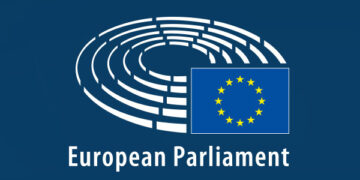EU officials and national politicians have championed “digital sovereignty” as a solution to online disinformation, cyber threats and the power of non-European tech companies. Drawing on a new special issue, Anke Obendiek, Gerda Falkner, Sebastian Heidebrecht and Timo Seidl highlight how the term is influencing policy and political discourse across the EU.
As digitalisation has become a key issue in the EU, policymakers face the dual challenge of fostering digital markets while simultaneously regulating them. Growing concerns about disinformation, surveillance and the excessive market power of US and Chinese tech companies have prompted calls for a distinctly “European approach” to digital policy.
Leaders such as Emmanuel Macron, Angela Merkel and Ursula von der Leyen have emphasised the need to strengthen European values and increase public control, distinguishing the EU’s ambitions from the US laissez-faire approach and the strictly state-controlled system in China. Digital sovereignty has become the central guiding principle for this approach.
Digital sovereignty describes the attempt to assert “control of the digital” on three layers: the physical layer (resources, infrastructure, devices); the code layer (standards, rules, design); and the information layer (online content, data). However, despite widespread use among high-level officials, think tanks and scholars, the term is characterised by conceptual fuzziness and a lack of reflection on the relevance behind the buzz.
What does digital sovereignty mean at the policy level? And is its relevance universal across issue areas? We have edited a new special issue investigating these questions across nine key areas of EU digital policy. Our findings show comprehensive policy change, as the EU becomes increasingly assertive. However, the relevance of digital sovereignty in policy-related discourse varies depending on the issue area.
Comprehensive change across digital policy areas
The nine areas of EU digital policy we cover are artificial intelligence policy, cloud policy, competition policy, copyright policy, digital finance regulation, external relations, industrial policy, internet content regulation, and internet standard-setting. Strikingly, our findings suggest that significant changes toward more control at the policy level have occurred in all but one area. None of these areas feature a complete absence of the digital sovereignty discourse and policy change.
Whether in copyright, artificial intelligence, or digital finance, EU policymakers seem to have tightened their grip by adjusting fines, introducing new policy instruments or by changing the overarching direction of policies. For example, the Digital Markets Act, which emerged as a compromise among competing claims within the Commission, represents a shift towards a more “dirigiste” EU competition policy. Meanwhile, EU industrial policy seems to be undergoing a “geo-dirigiste” turn, directing markets into strategic sectors. And in the realm of internet standards and protocols as well as in artificial intelligence, the EU’s vision for the future entails a growing assertiveness in influencing global processes.
But, strikingly, on a discursive level, changes are much less uniform. There are at least four areas where policy change towards digital sovereignty without a corresponding discursive change can be observed. An increasingly important security discourse has extended public responsibilities in digital finance, broad public order concerns are driving regulatory action in content regulation, and during the contested reform of the Copyright Directive in 2019, politicians referred to “European values and culture”. However, there were either few explicit uses of digital sovereignty or the term was “indistinctive” from other concepts, such as in external relations.
Trade-offs and strategic usage
Considering the term has been referred to in major speeches and strategic documents, the variation in the use of digital sovereignty as a term is surprising. Indeed, in some areas, digital sovereignty has become a politically beneficial tool, serving as a “coalition magnet” that unites diverse actors behind a common agenda or providing a “repertoire of ideas” for various actors, helping to bridge competing interests.
However, the use of digital sovereignty can also be costly. Some actors avoid the term due to associations with protectionism or interventionism. And in digital policy specifically, the notion of sovereignty has long been associated with the potential for restrictions, censorship and undue state influence on the global internet, encouraging democratic actors to rely on alternative terms in cyber diplomacy, external capacity building or content regulation. Moreover, in relation to the EU’s AI strategy, there are problems associated with the over-ambitious and Eurocentric nature of the EU’s ambition to achieve “AI sovereignty”.
In cloud policy, country-specific ideological legacies and political constellations make the term more prominent in Germany and France than in the Netherlands and Poland. In digital finance, long-standing legal traditions mean there are few benefits from introducing a new term, but it may be used by public authorities to justify moves into new areas of regulation.
These differences reflect what we call specific ideational trade-offs in each policy area: whether and how actors use the language of digital sovereignty depends on costs and benefits that differ across policy (sub-)areas. Some actors can benefit from the usage of the digital sovereignty term to build coalitions or fight opponent lobbying groups, while others wish to avoid appearing over-interventionist and anti-liberal.
In summary, our findings show that the discourse on digital sovereignty is not just empty rhetoric but an important element in broader changes to EU digital policy. While the term itself may not always be the driving force, significant policy changes reflect the EU’s attempt to increase its control of the digital space.
For more information, see the accompanying special issue in the Journal of European Public Policy, edited by Gerda Falkner, Sebastian Heidebrecht, Anke Obendiek and Timo Seidl.
Note: This article gives the views of the authors, not the position of EUROPP – European Politics and Policy or the London School of Economics. Featured image credit: Alessia Pierdomenico / Shutterstock.com



































Discussion about this post